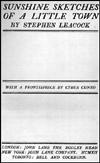


 |

Homepage |

Contents |
 |
The Structure of
Sunshine Sketches |
Below is a diagram illustrating the structure of Sunshine Sketches of a Little Town. By comparing the relatively simple narrative structures of both Arcadian Adventures and Sunshine Sketches, one notices that Leacock's vision of society is framed by the pragmatic realities of life: politics and economics. Set within this framework are the spiritual realities of life: love, family, social organization, and religion. It comes as no surprise that Leacock, as a professor of Political Economy, frames Sunshine Sketches and Arcadian Adventures by subjects he considers most relevant to a complete conception of society.
This is what Robertson Davies means when he said that Leacock thought that "the advances of mankind were brought about by economic and political, rather than by spiritual" (Stephen Leacock. Canadian Writers no. 7. Toronto: McClelland and Stewart, 1970. p. 26).
In Sunshine Sketches we witness in the first two chapters a successful business man and an unsuccessful business man. Mr. Josh Smith in chapter 1 is the successful business man, he turns a negative telegram into a window of opportunity, establishing the first café for Mariposans. In chapter 2, Mr. Jefferson Thorpe does the contrary of Mr. Smith, he squanders his investments on a bogus banana stock. Mr. Thorpe's investment strategies are a business failure. Chapter 3 provides us with a picture of Mariposan social life on the Mariposa Belle. The religious side of Mariposa is essentially a failure: in chapters 4, 5, and 6, the Mariposans fail to finance Dean Drone's church, and subsequently, they turn to burning the new church down for an outrageous insurance claim. Chapters 7, 8, and 9, however, reveal that success can indeed grow in the town of Mariposa, as Peter Pupkin falls in love and marries Zena Pepperleigh, and moves into an enchanted house. Chapters 10 and 11 depict the political side of Mariposa. The entire short-story cycle of Sunshine Sketches is framed by the two telegrams from the city to Mr. Smith, by the entrance of Mr. Smith and exit of Mr. Smith, and by the Preface and chapter 12. For a more thorough examination of Sunshine Sketches' structure see Gerald Lynch's Stephen Leacock: Humour and Humanity (Kingston, Ont.: McGill-Queen's University Press, 1988. pp.59-65)
| Preface |
(authorial narrator) |
Opening Narrative Frame |
| Mr. Smith enters Mariposa |
| * First Telegram: Smith rejected * |
| Chapter 1 |
"The Hostelry of Mr. Smith"
(*success) |
Economic |
Pragmatic
Realities |
| Chapter 2 |
"The Speculations of Jefferson Thorpe"
(*failure)
|
| Chapter 3 |
"The Marine Excursion of the
Knights of Pythias" |
Social |
Spiritual
Realities |
| Chapter 4 |
"The Ministrations of the Rev. Mr. Drone" |
Religious (*failure) |
| Chapter 5 |
"The Whirlwind Campaign in Mariposa" |
| Chapter 6 |
"The Beacon on the Hill" |
| Chapter 7 |
"The Extraordinary Entanglement
of Mr. Pupkin" |
Love/Family (*success) |
| Chapter 8 |
"The Fore-ordained Attachment of Zena
Pepperleigh and Peter Pupkin" |
| Chapter 9 |
"The Mariposa Bank Mystery"
|
| Chapter 10 |
"The Great Election in Missinaba County" |
Political |
Pragmatic
Realities |
| Chapter 11 |
"The Candidacy of Mr. Smith"
|
| * 2nd Telegram: Smith accepted * |
| Mr. Smith exits Mariposa
|
| Chapter 12 |
"L'Envoi. The Train To Mariposa" |
Closing Narrative Frame
|
Note: the asterisk mark, "*", beside the words "success" and "failure" refers to the oscillating narrative movement. Success is a turn upwards in the plot whereas failure is a turn downwards in the plot. These turns in the plot are only figurative outlines. See the above introduction for further details.
For a comparison with the structure of Sunshine Sketches press here for the structure of Arcadian Adventure.

Top |
|